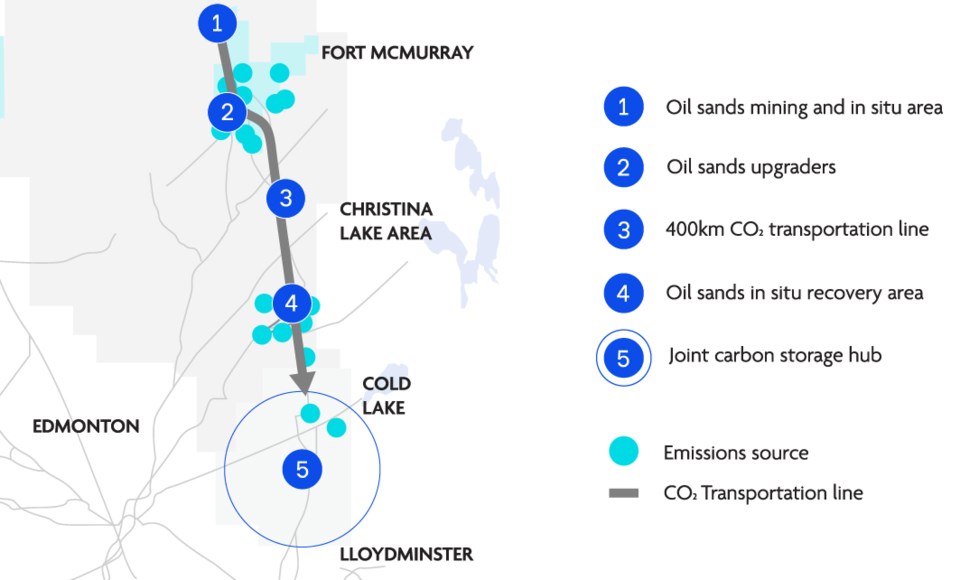LAKELAND – It is a proposal that will positively impact the entire Lakeland region and the environment, says Pathways Alliance vice president of external relations, Mark Cameron.
“Carbon Dioxide (CO2) is a greenhouse gas that is responsible for climate change. The main criticism of the Alberta oil sands industry is that it is very carbon intense,” Cameron acknowledged.
The Pathways vision is a major carbon capture and storage system line connecting up to 20 oil sands facilities in the Fort McMurray, Christina Lake and Cold Lake regions of Alberta to a carbon storage hub near the Cold Lake area.
Pathways Alliance is an organization made up of Canada’s six largest oil sands producers working together to address climate change.
The six companies – Canadian Natural, Cenovus Energy, ConocoPhillips Canada, Imperial, MEG Energy, and Suncor – operate about 95 per cent of Canada’s oil sands production.
Coming together under the umbrella of Pathways Alliance, their plan is to achieve net zero greenhouse gas emissions in oil sands production by 2050.
“If we're successful in capturing the carbon and storing it permanently underground, then we remove one of the major environmental concerns with the oil sands development,” Cameron told Lakeland This Week.
“We think we can essentially sequester most of the emissions that would be generated by oil sands production for the rest of the life of the existing oil sands assets.”
The proposed locations for the carbon sequestration well sites, a carbon storage hub, are being considered in areas south of Cold Lake, but further geological testing will occur in several areas including Bonnyville and Lac La Biche, according to the vice president.
“We are looking at drilling exploratory wells, testing the carbon sequestration capacity,” he said. “Geologically, this is a very good location for carbon capture.”
The organization describes Alberta’s Sedimentary Basin as an ideal geology for the safe, permanent storage of captured CO2, describing the area’s multiple overlying layers of impermeable rock formations as natural seals.
Cameron said studies are being carried out to carefully select site locations and extensive monitoring will ensure the injected CO2 remains sequestered and does not impact the environment or geological stability.
“The formations that are in northeastern Alberta are extremely stable. So, we don't really think that there is any risk of seismic activity like what's happens in some cases with fracking for natural gas, but the risk is really minimal for carbon capture and that’s part of the reason we are doing these test wells,” said Cameron.
If the Pathways’ carbon capture project is given the green light, CO2 from oil sands sites will be piped to a hub facility and injected deep below the Earth’s surface into to the layers that are called saline aquifer formations, typically between one and two kilometres underground.
“We have to essentially drill down to find the level those are at and then test to make sure that any CO2 that is injected there, remains there,” he explained.
Cameron noted that this depth is well below any freshwater sources. Freshwater in this area is typically around 150 metres below surface, according to information provided by Pathways.
The impact
Cameron said carbon capture and storage technologies are safe, proven and reliable technology that have been used in Canada - and all over the world.
“We already have about 40 million tonnes of carbon capture going on in Canada already, so this is just doing it at a larger scale,” stated Cameron, referencing the Quest Project near Edmonton, the Alberta Carbon Trunk Line, and the Weyburn carbon capture project in Saskatchewan.
For the Pathways project, which has three phases, it will take several years to reach completion, Cameron acknowledged, but efforts remain ongoing to consult and engage with local municipalities, First Nations, Métis Settlements, stakeholders and the provincial and federal governments.
“There's been a lot of dialogue about the regulatory process and about what kind of fiscal support will be needed for this project,” said Cameron, noting discussions have been complex.
Getting approval to build a pipeline for the transportation of captured CO2 could take between two to four years, depending on which governmental body takes on the regulatory process, he noted.
There is also the matter of constructing sequestration facilities and sites. Cameron hopes that some parts of the project could break ground as early as 2025.
“If you want to achieve 22 million tonnes [of captured CO2] by 2030, we have to start as soon as possible,” he added.
Finances
Cameron acknowledged the Pathways project is almost entirely “pure cost,” meaning no revenue will be generated from it.
A program for investment in tax credit rolled out by the federal government could help, but more governmental support is needed, he said.
“On the fiscal side, these projects are extremely expensive. We're talking about $16.5 billion investments to create the carbon capture network between now and 2030, and the projects don't create any additional revenue, they don't create any additional oil production or anything like that,” said Cameron.
While there are costs, there are also economic benefits. The construction phase could add between 25,000 to 30,000 construction jobs to the region by the late 2020’s as work to develop the pipeline and the sequestration area takes place, along with building carbon capture projects on all the different oil sands sites.
Following construction, it's predicted that over 1,000 permanent jobs could be retained in the region, Cameron said.
“I can’t really get into specifics on how it’s going to impact specific local municipalities because the pipelines and routes haven’t all been determined, but obviously that many jobs added to the region will have an impact on the communities,” he said.
Anyone looking for more information on the project can visit the organization’s website or reach out directly, Cameron said.



